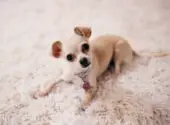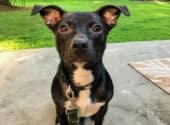I’m like one of those little Chihuahua’s that thinks they’re ten feet tall – Alexander Volkanovski
Contents show
The Chihuahua has always been the biggest dog in any and every yard that it wanders into.
At least, it is in its own mind. No one ever told the Chihuahua that it couldn’t rub shoulders with Great Danes and German Shepherds, and even if they had, it wouldn’t have listened.
A little dog with a mighty heart and a personality that matches the infinite size of its spirit, the Chihuahua tore up and threw away the size rulebook.
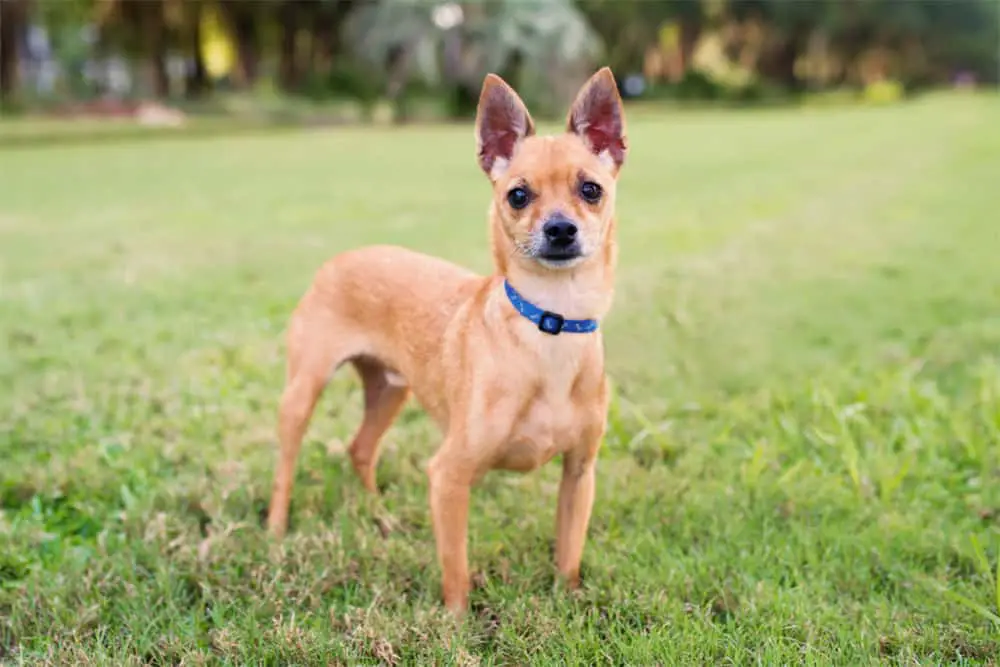
A breed and a law unto itself, the Chihuahua is the toy dog that thinks it’s a wolf and is a fearless defender of its family and territory.
It’s a dog that has never let its size get in the way of making the most out of every second of every day, and its infectious lust for life has made sure that the Chihuahua has become one of America’s most beloved dogs.
And even though it isn’t native to the US, thanks to its endless charm and bravado, it’s found its new home in the hearts of the nation’s dog lovers.
But there’s more to this adorable little canine than meets the eye, and its size isn’t the only thing that separates one type of Chihuahua from another, and in order to paint a much clearer picture of the Chi and how the world looks through its eyes, we thought it was about time that we took an in-depth look at the Deer Head Chihuahua.
We know, you’re probably thinking “What is a Deer Head Chihuahua and why haven’t I heard of them before now?”, but don’t worry, as we’re going to answer both of those questions and a lot more in our comprehensive guide to the flat headed little conquistador from South of the border.
What Is A Deer Head Chihuahua?
What’s in a name? As far as the Deer Head Chihuahua is concerned, everything as their name describes exactly what they look like. Their heads are longer and flatter than those of their Apple Head Chihuahua cousins, even though they’re almost identical in every other respect.
How did this little dog get its name? It’s known as Deer Head because its head looks like the head of a fawn or a young deer.
Their faces are also longer and more like those of the Xolo, which has led some canine enthusiasts to speculate that there might be some of the native Mexican canine’s DNA in a Chihuahuas genetic make-up, which would explain where the Deer Head originally came from.
So There Are Two Types Of Chihuahuas?
Yes and no. Yes, there are two breed standards of Chihuahua, Apple Head and Deer Head, but there are actually six different types of Chihuahua and they are the aforementioned Deer and Apple head dogs, the long and smooth-coated varieties of the dog, the even smaller Teacup version and Fawn colored Chihuahua.
You’re probably thinking that’s a lot of different dogs that are sheltering under one breed umbrella, and it must be difficult for the AKC (American Kennel Club) to keep a tight rein on each and every type of Chi, and you’d be right if the AKC actually recognized all six types of Chihuahua. But they don’t.
The American Kennel Club And The Deer Head Chihuahua
This is where things get a little confusing in the world of the Chihuahua, as even though most Chi owners know that there are six distinctly different types of Chihuahua, the American Kennel Club only recognizes two.
And they’re not the two that you probably think they are.
The AKC only recognizes the long and smooth-haired versions of the Chihuahua, and even though you can register a Deer Head Chihuahua with the Kennel Club, you won’t be able to enter it into any official competitions.
Actually, that’s not technically true, you can enter a Deer Head Chihuahua in an American Kennel Club sponsored and endorsed event, but it won’t win any prizes and it won’t bring home a trophy that’ll take pride of place on your mantle.
Deer Head Chihuahuas don’t win the hearts and minds of show judges because the AKC guidelines for the breed are based on the appearance of a dog, and in the Chihuahua’s case, those appearance guidelines are all based on the Apple Head and not the Deer Head.
If they don’t have the desired Apple-shaped head that the AKC values and adores, then they won’t win. If you want your Chihuahua to bring home the bacon, the only way to go is with an Apple Head.
Deer Head Vs Apple Head
Okay, so we’ve spent a lot of time talking about the shape of the Chi’s head, and while we’ve gone into a little detail about how the Deer Head version of the dog got its name, we haven’t talked about the Apple Head.
This means that maybe it’s time that we did, in order to help you understand the differences between the two.
Apple Head Chihuahuas are the breed standard and the flag bearers for this infamous Mexican dog, and as their name suggests their heads are more rounded than those of the Deer Head and have a more dome-like appearance.
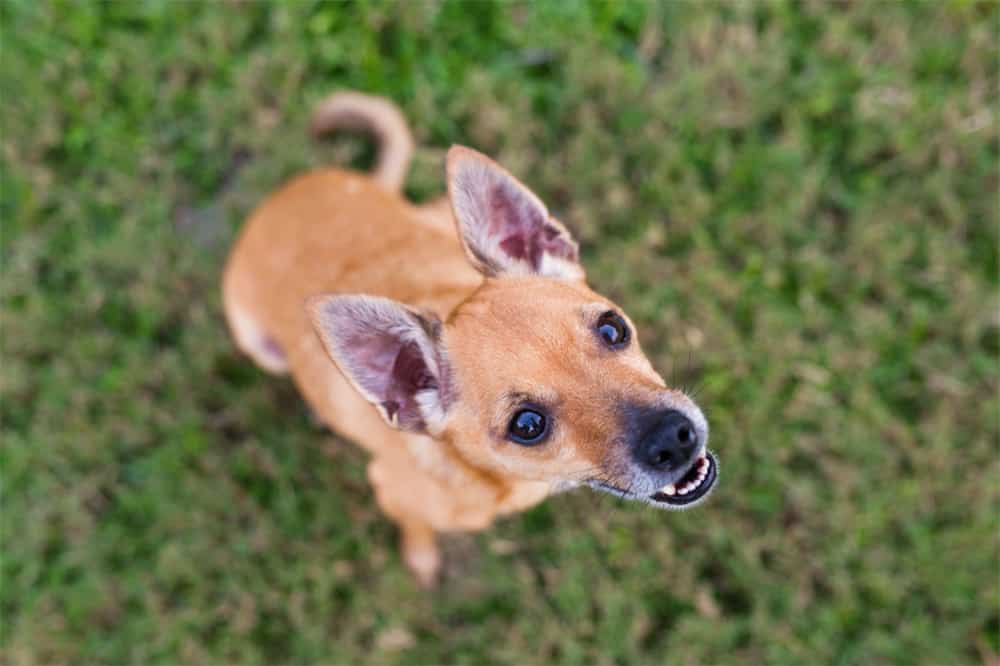
This isn’t the only difference between the two different types of the same dog, as Deer Heads are usually slightly bigger and longer than Apple Head’s, their ears tend to be larger and their muzzles are longer than the short snouts that Apple Head dogs have.
The biggest difference and the one that most owners notice is that Deer Head Chi’s tend to be healthier and slightly tougher than Apple Head’s are. And it’s primarily because of the shape of their heads, and the fact that the flat-headed dogs don’t have the same soft spot at the top of their skulls as Apple Heads do.
Why does this make such a huge difference? Well, it effectively negates the major health issue that the breed is prone to, hydrocephalus, which is a build-up of fluid in the cranial cavity that can cause seizures and eventually, if left untreated, causes long-term brain damage.
The lack of the soft spot and the different shape of thor head means that the AKC frowned on the version of the Chi that is much less likely to be plagued by the breed’s common genetic defect.
They might not be as highly prized as the Apple Head is among breeders, but Deer Head Chihuahuas are much tougher than their slightly smaller brothers and sisters.
The Health And Wellbeing Of The Deer Head Chihuahua
We’ve opened the door to the health and wellbeing of the Deer Head, so we may as well take the opportunity to walk through it and talk about some of the health issues that could potentially be a problem for a Deer Head.
While we’ve already discussed the fact they’re less likely to develop hydrocephalus than an Apple Head is, that doesn’t mean that they won’t develop some of the other genetic conditions that their breed is susceptible to. After all, at the end of the day, they’re still Chihuahuas.
One of the things that has helped to endear the Chihuahua to generations of fans is the fact that it’s generally a hardy little dog, It isn’t bothered by any day to day ailments or maladies and is unusually averse to the stomach and digestive problems that can be the everyday downfall of other, much larger and physically tougher breeds.
Which just proves that appearances can be deceptive and things aren’t always what they seem to be.
There are, however, a number of health problems that a Deer Head could suffer from during its lifetime, simply because it is a Chihuahua, and these include:
Tracheal Collapse
Don’t panic, it isn’t as bad as it sounds and it can be treated surgically but forms the reason Chihuahua’s are one of the breeds that can be affected by this condition.
It usually occurs when a dog tries to gulp in too much air after a prolonged period of exercise, and the rapid influx of air then causes the trachea to flatten and swell, which can make it more difficult for the dog in question to breathe.
If this does happen, or you’re concerned that it might be happening, take your dog to their vet straight away and they’ll be able to immediately treat your best friend, and alleviate his symptoms.
Heart Problems
Chihuahua’s are susceptible to heart trouble, which usually manifest in one of two ways.
They can either be born with heart murmurs, which a vet will easily be able to detect during a routine check-up and suggest a course of treatment for.
While a murmur isn’t usually serious and won’t pose any threat to a Deer Heads wellbeing or quality of life, in rare cases where they do pose a potential risk to the dog’s long-term health, the defect can be repaired with elective surgery.
The second cardiac issue that Chihuahuas are prone to is pulmonary stenosis, which is a malformation of the pulmonary valve that can lead to the valve becoming blocked and ultimately, cause a cardiac arrest.
Unless the condition is serious, it won’t usually be picked up during a veterinary examination and if it is, the vet in question will usually suggest the valve should be repaired surgically.
The Soft Spot (Open Fontanel)
We’ve already mentioned that Apple Head Chihuahuas are born with a soft spot in their skulls, and usually this will eventually take care of itself as the dog enters adulthood.
The phrase that any potential Chi parent needs to focus on is “usually”, as it doesn’t always heal, which can increase the chance of a Chi being hydrocephalic.
It isn’t however, something that Deer Head parents need to think, or even worry about, as it isn’t a problem that bothers flat headed dogs.
The Shakes And Shivers
Chihuahuas shake and shiver, and no one seems to know exactly why, as they do it when they’re cold, excited, and happy. It isn’t anything to worry about and Apple and Deer Head Chi’s both shake and shiver, and the chances are, they’ll do it when you least expect them and for reasons known only to themselves.
It can be scary the first couple of times that you see it happen, but as we’ve said, it isn’t anything that you need to be concerned about. Chihuahua’s shiver, it’s just something that they do.
It might seem like a long list of potentially expensive issues that could burn a mile-wide hole in your bank balance, but the chances are that if you adopt or buy a Deer Head Chihuahua, they won’t be bothered by any of them.
But that’s what pet insurance is for, as long as you’re prepared and have insured your dog, if they do rear their ugly heads, you’ll be able to lean on your policy to cover any, and all vet bills.
The Life And Times Of A Deer Head Chihuahua
While we’re talking about the health and wellbeing of a Deer Head, we might as well tackle the one thing that no one ever seems to want to talk about head-on, and that’s how long they live for.
Small dogs live longer than big dogs do, and as it’s one of the smallest breeds of dog in the world, the Deer Head Chihuahua has, for a dog, an extraordinarily long lifespan.
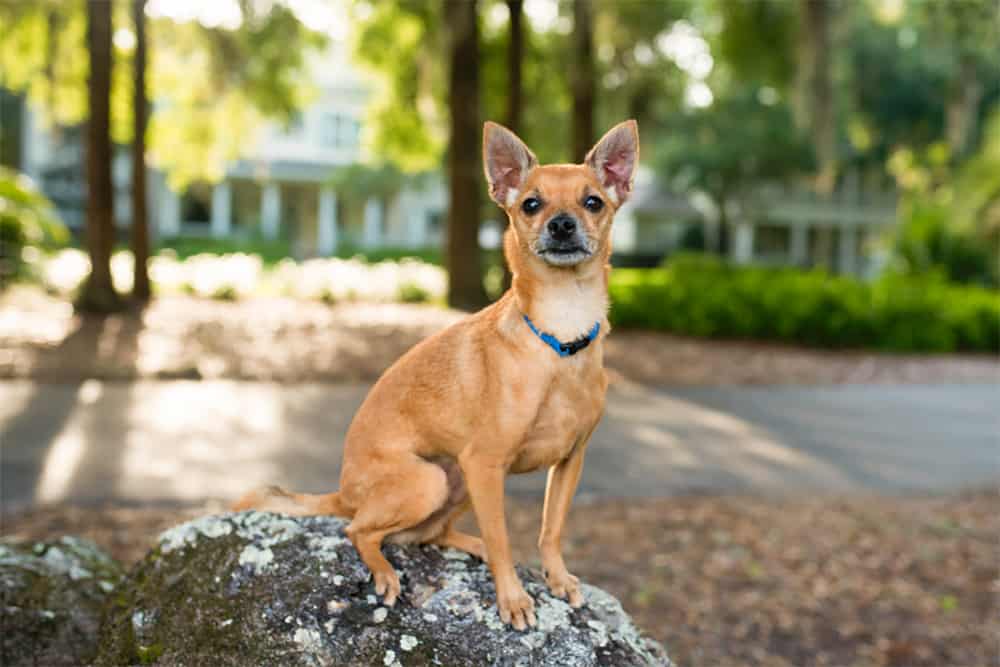
On average, they tend to live between fourteen and sixteen years, but it isn’t uncommon for a Deer Head to reach the ripe old age of twenty. In other words, if you’re thinking of adding a Chihuahua to your family, you’ll need to understand that a Chi really is for life.
How Big Is A Deer Head?
Even though the Chihuahua is, according to the Guinness Book Of Records, the world’s smallest breed, the Deer Head is the largest dog in the Chi yard.
Most Deer Heads tend to be between eight to ten inches tall at the withers (that’s the space immediately between the shoulders) and usually weigh between four and eight pounds. While they’re big for a Chihuahua, they’re still small dogs.
Deer Head Loyalty
Deer Head Chihuahuas are incredibly loyal dogs, but they suffer from the same loyalty problem that a lot of Chihuahuas do; they tend to become overly attached to one person.
They choose a favorite person and that individual, whether they like it or not, becomes the Chi’s owner.
They’re also incredibly jealous dogs and are possessive of their chosen person which can be slightly problematic in a family environment as they can be aggressive toward anyone that they think might be a threat to their relationship with their owners.
It also means that they’re unlikely to listen to or obey anyone other than the person that they’ve attached themselves to.
The problem is, until you bring the Deer Head home, you won’t know which member of your family they’re going to choose. They form intense, close bonds, and the only way to effectively combat this part of their personality and nature is by ensuring that a Chi is properly trained and socialized from an early age.
Are Deer Heads Good Family Dogs?
They can be, as long as their owners are aware of the breed’s tendency to bond with a single family member, rather than the family as a whole.
With the right training and socialization, this behavioral trait can be effectively dealt with and a Chi can become a family dog who is content to spend time with all of his pack.
Any prospective Chi owner also needs to be aware that the breed is also prone to territorial aggression, which means that they will fiercely protect anything that they consider to be theirs (food, toys, blankets, and even their favorite person), which is an issue that needs to be dealt with as soon as possible.
Even though Chi’s are usually good with children, because of their size, and the fact that they could easily be hurt by toddlers and attempt to defend themselves from them if they perceived them to be a danger to their own wellbeing, Chi’s aren’t recommended for families with young children.
The Deer Head Temperament
For some reason known only to Chihuahuas, Deer Heads tend to be less aggressive and angry than Apple Heads are.
Maybe it’s a size thing, or maybe it’s just because the dog feels like it has less to prove to the world than its AKC-approved brothers and sisters, but it is a generally calmer and more relaxed dog.
Having said that, a Deer Head is genetically programmed to be a Chi, which means that as well as being loyal, affectionate to its owner and fiercely protective of its family, it’s also stubborn and wilful and loves to be the center of everyone’s attention.
Chihuahuas can be aggressive toward strangers, other dogs, and people that they don’t know, which is a facet of their territorial behavior, but if they’re socialized and trained while they’re still young, all of the negative elements of a Chi’s personality can be easily controlled.
Shedding, Drooling, And The Deer Head
They shed all the time, day in and day out, all year round. The good news though is that Deer Heads aren’t heavy shedders and their owners don’t need to chase after them with a vacuum cleaner to keep their floors and furnishings fur-free.
However, the amount that they’ll shed depends on whether they’re long or smooth-coated (Deer Heads can be either), and the former needs to be groomed more thoroughly than the latter, as long-coated Chi’s need to be brushed a lot more than smooth-coated Chi’s do.
The good news though, is that Deer Heads don’t drool unless they’re waiting for their dinner bowls to land on the kitchen floor or they’re patiently waiting for you to give them a little bit of whatever it is that you’re eating.
Apart from drooling when they think there’s a tasty treat on its way, their spittle tends to stay where it was meant to. Inside their mouths.
Coats And Colors
Like their Apple Head brethren, Deer Head Chihuahuas can have either long or smooth coats, and the length of their fur isn’t dependent on the shape of their heads or their size. And neither is the color of their fur, which can be Red, Tan, White, White, Brown, Black, Silver, or Tan.
Deer Head Ears
One of the cutest things about Chihuahuas is their ears which seem to be permanently standing to attention, but when they’re born their ears are floppy and don’t actually start to stick up until they’re six months old.
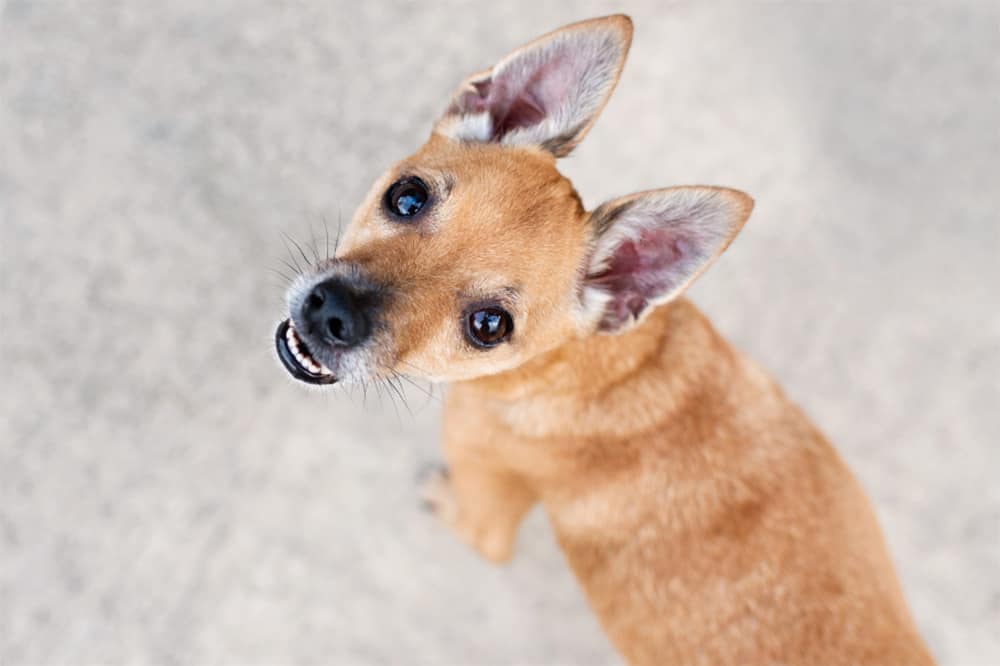
It takes at least half a year for the cartilage which ensures that their ears always look like they’re ready to react to the slightest sound, to form and imbue them with their distinct and unique appearance.
Deer Head Denning
Have you ever wondered why Deer Head and Apple Head Chihuahuas like to dig burrows and tunnels in blankets and towels? It’s an instinct called ‘denning’, and is similar to the nesting behavior that other dogs display when they circle around before settling in their beds.
Chi’s like to dig “nests’ ‘ and burrow into blankets and towels to make dens to escape the cold and create a warm place to sleep.
While it’s an adorable quirk, it does mean that their owners need to be constantly careful about where they sit or lie as their dog could be hidden on the couch or wrapped up in the blankets of their beds.
The Little Dog With A Lot Of Get Up And Go
Don’t let the Deer Head’s size fool you, this inquisitive, curious little dog is full of energy and loves to explore the world and his surroundings.
He may be small, but the Deer Head Chihuahua needs a lot of exercise and any potential owner needs to be outside at least an hour a day to make sure that he gets all of the exercise time that he needs.
Ideally, he’ll need a half hour walk in the morning and another half hour walk in the evening, as there’s so much for him to see and do that he’ll be eager to get and make sure that he’s the first dog to find all of the exciting scents and sniffs that he can.
It’s a big time commitment and one that every Chi owner needs to be prepared to sign up for.
Can A Deer Head Chihuahua Live In An Apartment?
In a perfect world, a Deer Head would have a yard or a garden to roam in, but the world is far from perfect and sometimes we just have to make do with what we have, which means that we need to love where we can and within our means.
Worry not though, as Deer Heads are ideally suited to apartment life as long as they get enough exercise and have a chance to burn off all of their excess energy, a Chi can happily live in any space, big or small, as long as their favorite person is with them.
The Loneliness Of The Deer Headed Chihuahua
As a breed, Chihuahuas are extremely prone to separation anxiety, which means that they don’t like being left on their own for long periods of time.
They become fretful and worried, and can become destructive and incredibly vocal if they have to spend too much time by themselves. And as small as they are, they can chew through soft furnishings and shoe collections in a surprisingly short amount of time.
They’re not exactly quiet either, and Deer Heads are adept at making their feelings known and letting their owners know exactly what they want when they want it, which means that they like to bark a lot.
Any dog owner who wants a quiet life needs to carefully consider whether an incredibly vocal Deer Head Chihuahua is the right dog for them.
Training A Deer Head Chihuahua
There are a lot of myths and misconceptions about Chihuahuas and one of the most enduring is that they’re not particularly bright.
That’s a fallacy, as they’re actually intelligent dogs, but their stubbornness and the fact that they only want to do what they want to do when they want to do it has led a lot of owners to believe that they’re not the sharpest denizens of the canine kingdom.
Deer Heads are clever little dogs, but their stubborn streak makes them difficult to train, which means that their owners need to be prepared to dig in and be patient. They respond well to positive reinforcement and reward based training, and even though it will take time, they will get there in the end.
They can also be notoriously difficult to house train and benefit from having a crate in the home, where they can retreat to when they need their own space, and which should help to housebreak and toilet train even the most wilful Deer Head.
Buying A Deer Head Chihuahua
There’s good news and bad news when it comes to buying a Deer Head. They’re not cheap, no pedigree dog is, but they’re not as expensive to buy as Apple Head Chihuahuas are.
Because they don’t conform to the exacting breed standards and show dog guidelines of the AKC, most breeders don’t charge as much for Deer Heads as they’re seen as being inferior to Apple Heads, which means that a Deer Head puppy usually costs between eight hundred and thirteen hundred dollars.
However, there is a far more affordable and easy way to give a Deer Head home.
As they’re such popular dogs, Chihuahuas are often left in the care of shelters and if there isn’t one in yours, you could always try giving a specialist Chihuahua (a quick internet search will reveal the closest one to you) rescue a call, as your best friend could be waiting for to swing by and pick him up. And adoption, as well as being far more affordable, is also more humane than shopping for a dog.
Can I Be Or Service?
You might not think it to look at them, given their size, but Deer Heads are prized as service dogs.
Granted they’re not suited to police work and they don’t make great watchdogs, but because they form such tight emotional bonds with their owners, they do make exceptionally good emotional support dogs.
As we’ve said throughout this article, don’t let a Deer Heads size fool you, they’re remarkable little dogs.
Deer Head Chihuahua Fun Facts
If you’re thinking that you’ve seen a Deer Head Chihuahua somewhere before, it’s because you have.
Throughout the late nineties and during the first five years of the new millennium, Taco Bell’s mascot and the dog that they used in their television adverts was a Deer Head Chihuahua called Gidget, whose illustrious show business career also led to a starring role in Legally Blonde 2.
Following a brief period of retirement, Gidget passed away in 2009 at the relatively young age of 15, after she helped to make her breed famous throughout America.
And finally, did you know that it was once believed that Chihuahuas could cure asthma and other allergies?
While that particular bit of folklore has faded into obscurity, the legend is thought to have been inspired by the fact that the Aztecs used to be buried with their dogs so that they could bear the burden of their owner’s sins and allow them to pass into the afterlife, free from the weight of the mortal realm.
Like we told you in the beginning, there’s more to these little dogs than meets the eye.


